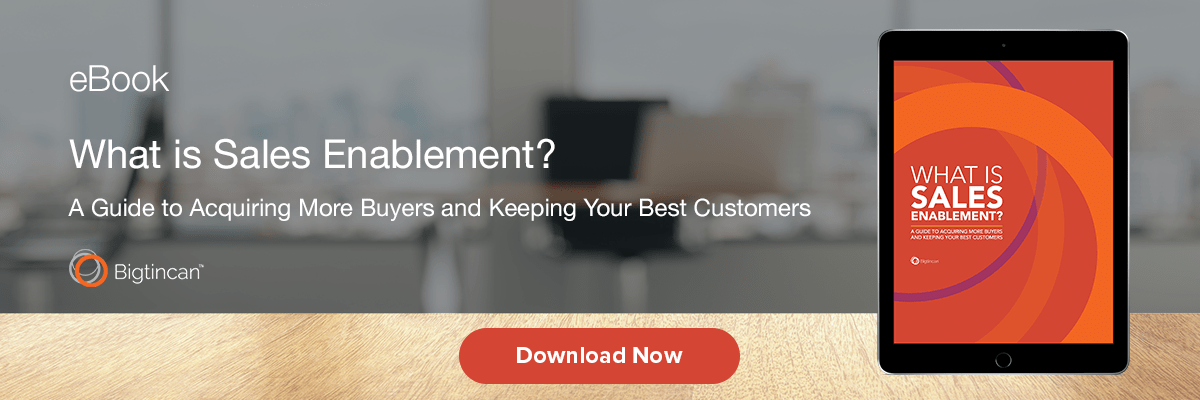This post is a snippet from The Essential Guide to Sales Enablement for 2019
Content is the glue that binds together the elements of a successful sales enablement strategy and key to the successful alignment of Sales and Marketing. The main content capabilities of best-in-class sales enablement automation (SEA) platforms include:
- Content Creation: The best sales enablement automation platforms enable content developers to easily upload and store content created in virtually any native format, by any third-party program. They also enable salespeople and marketers to edit assets in their native format within the context of the SEA app. Formats include, but are not limited to, audio, video, HTML pages and forms, HTML5 apps, PowerPoint-style presentations, documents such as Word and Google Docs, PDFs, spreadsheets and animations.
- Content Organization: When uploading content to the SEA, the user can tag assets with attributes that will help deliver the most relevant content to the right user at the right time on any mobile device or desktop system. Tagging attributes are unlimited and informed by your sales enablement strategy. Common examples include user role, access permissions by role, buyer persona, stage of the customer's journey, target device type, vertical (e.g., life sciences, banking, manufacturing, retail), regulations, compliance, geo and language. Advanced SEAs use artificial intelligence (AI) and machine learning to automate tagging, sharply reducing manual tagging requirements.
- Contextual Recommendations Powered by AI: Advanced SEAs leverage AI to recommend to salespeople and partners what content will be most relevant to them based on contextual variables like those described above as tagging attributes. Recommendations are a tremendous time-saver, freeing sales reps from endlessly searching for the most relevant content and enabling Marketing to push out the latest version of an asset to ensure its accuracy and applicability to the buyer or customer.
- Intelligent Push Architecture: An SEA must include this powerful capability. Legacy solutions typically require reps to press a sync button or manually download content to their devices’ file systems. Leveraging AI, the SEA automatically pushes out the most relevant or recent version of an asset to sale reps and partners. Additionally, SEAs let marketers push out the most up-to-date assets manually.
- Access: SEAs enable content creators to precisely control access down to the individual asset. Permissions are based on such variables as role, level in sales organization (e.g., junior, senior, manager, partner), regulation and compliance concerns, vertical and target company.
- Device Distribution: Ideally the SEA can push content to any device, including mobile devices (e.g., smartphones and tablets), desktops, web browsers and email — in real time to support the rapidly changing needs of road warriors. Additionally, the SEA should provide both online and offline access to relevant content, as well as a seamless native experience on each device to that promotes SEA adoption by sales reps.
- Custom Content Creation: SEA apps must allow salespeople to modify content in its native format to respond immediately to change. For example, a rep may find out an hour before a presentation that a prospect's director also will attend. The sales rep can quickly edit the presentation in PowerPoint or his or her chosen application to tailor it to the pain points of the additional attendee. The SEA must recognize these events and log the content changes and new version to the CMS via tagging powered by AI to prevent content duplication and confusion. Storing the data associated with this new version also allows AI to recommend and push that asset to other reps in similar selling situations.
- Browsing and Search: Even with the AI recommendations and push publication, sales reps and partners still require fast and efficient browsing and search capabilities.
- Email Integration: One of the most powerful content distribution methods combines AI recommendations and email templates. When a sales rep is interacting with a buyer, the SEA embeds recommended content in email messages to the buyer based on contextual variables. Additionally, the SEA can recommend to salespeople what to embed in their messages based on variables such as the buyer's last action taken, vertical, role and stage in the journey.
- Martech stack integration: SEAs must integrate seamlessly with the other technologies in the martech stack. All buyer interactions with content must be logged to the CRM system to provide salespeople with a complete record of the buyer-seller relationship and journey. SEA platforms must integrate with marketing automations systems to trigger processes such as email nurturing campaigns. Finally, the SEA platform must work with the CMS to ensure that content is delivered immediately and accurately across the content delivery network and internet.
- Advanced analytics and reporting: Data is Sales and Marketing's best friend. All of a buyer or customer's interactions with content must be recorded and saved to paint the most detailed picture of buyers and their activities and behaviors. Analyzing and reporting on this data provides Sales and Marketing previously unmatched insights into buyers, customers and accounts targeted via ABM programs. Additionally, this data is used by AI to make contextually based recommendation. Again, all this data must be logged to the CRM system to provide salespeople with a complete record of the buyer-seller relationship.
